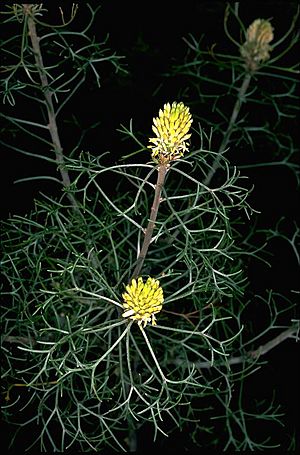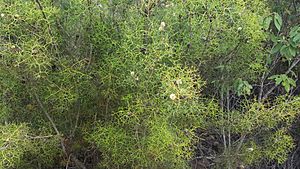Prickly conesticks facts for kids
Petrophile sessilis, also known as prickly conesticks, is a cool flowering plant that belongs to the Proteaceae family. It's special because it only grows in New South Wales, Australia. This plant is a tall, upright bush with stiff, needle-like leaves that have sharp points. It also has pretty, creamy-yellow flowers that grow in oval, spike-like clusters.
Quick facts for kids Prickly conesticks |
|
|---|---|
 |
|
| Petrophile sessilis near Bylong | |
| Scientific classification | |
| Genus: |
Petrophile
|
| Species: |
sessilis
|
| Synonyms | |
|
|

Contents
What Does It Look Like?
The prickly conesticks plant is an upright bush. It usually grows up to 3 m (9.8 ft) (about 10 feet) tall. When the plant is young, its branches and leaves feel soft and silky. As it gets older, these parts become smooth and hairless (this is called glabrous).
Leaves and Flowers
The leaves are 30–100 mm (1.2–3.9 in) (about 1 to 4 inches) long. They are divided into many stiff, needle-shaped parts. These small parts are usually less than 10 mm (0.39 in) (less than half an inch) long and have sharp points.
The flowers grow in oval, spike-like clusters. These clusters are about 20–25 mm (0.79–0.98 in) (about 1 inch) long. They appear at the ends of branches and where leaves meet the stem. At the bottom of each flower cluster are broad, egg-shaped leaves called involucral bracts.
The flowers themselves are 10–14 mm (0.39–0.55 in) (about half an inch) long. They are creamy-yellow and feel silky to the touch.
When Does It Flower?
Prickly conesticks mainly flowers from May to February. After flowering, the plant produces a type of fruit called a nut. These nuts grow together in an oval head that can be up to 35 mm (1.4 in) (about 1.4 inches) long.
You can tell this plant apart from a similar one, Petrophile pulchella, by looking at its new growth. Prickly conesticks has fine hairs on its new shoots.
How It Got Its Name
The scientific name Petrophile sessilis was first officially described in 1827. This happened in a big book called Systema Vegetabilium, which was the 16th edition. The description was written by Josef August Schultes. He used notes from an earlier, unpublished description by a person named Franz Sieber.
Where Does It Grow?
Prickly conesticks loves to grow in sandy soils. You can find it in different types of natural areas. These include heathlands, woodlands, and forests. It grows in New South Wales, specifically from the Central Coast area all the way to the Central and Southern Tablelands.

